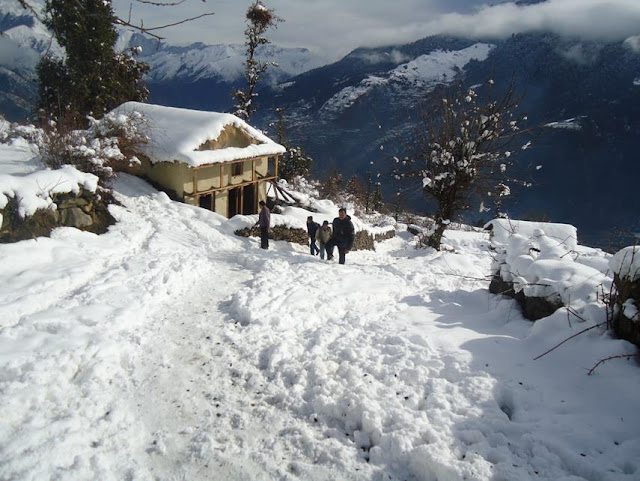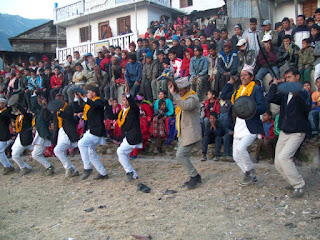Manang Valley Trek

Manang Valley Trek Lying of the eastern reaches of the Annapurna Circuit Trek, Manang village Trek is a remote yet one of the most beautiful valleys in Nepal. In the close vicinity of Tibetan border, this valley has a history among the yak and salt traders of Nepal and Tibet. This valley is still used as the yak and salt trading point and it remains one of the important trading point is the northern border of Nepal. At the time of King Mahendra this valley was declared as the trading point of Nepal for the East Asia. Since then many of the manage people have migrated to Kathmandu and other places but to those who still live there, this is a very important place. Opened to trekkers in 70’s Manang Valley has been one of the favorite destinations for the trekkers visiting Nepal. Enriched and blessed with many stunningly beautiful mountains like Pisang peak, the Chulu range, Gangapurna, Tilicho Peak, Kangaru Peak, Throng peak, Manang Valley trek always has been a great experience for those who have been there.
Manang Valley Trekking Comprised of the 13 districts, Manang is divided to Upper and Lower Mustang. Marshyangdi River runs through the District making the land fertile and irrigable. Manangi People grow mostly buck wheat, millet and potato. The winters in the higher plateaus resemble desert like terrain but some of the rarest flora and fauna inhabit this place.
Manang Village Trek will take you through gorgeous lower valley full of life and beautiful flora and fauna to the desert like barren upper plateaus, beautiful nonetheless. Manang Valley trek will offer you view of the mountains that will sweep you off your feet, cultural aspects of the Himalayan region, the renowned Milirepa cave situated, only a day’s walk from Manang village and to the highest freshwater lake in the worl
Accommodations:
We give our first priority to our guest to serve them at superior level that is what making us today Himalayan Magic Treks. For the accommodation we have been providing star hotels in Katmandu and even normal guest house according to the guest demands and need. During the trek we provide standard Guest House with sound environment and hygienic food for the guest to make their trip happening and healthy. Being one of the paramount destination in the world Annapurna region collects lots of tourist. so, there will always be better Lodge and facilities in LManang Valley Trek.
We get paradise of food especially in the cities areas especially in Katmandu valley. We have a lot of restaurants with different cuisine in city but during the trek we get to eat from Continental and Nepali menu especially choices like Pasta, Pizza, Mo. Mo, soup items, Potatoes items, Dal Bhat, Hot drinks Tea & Coffee etc.
Being homeland of Himalayas, it’s obvious to have challenging routes, High altitude problems, Weather and other conditions; any of those situations is big enough to ruin your trip. Leading around the steeply hills and rocky routes is not a job of common climbers and trekkers. Himalayan Magic Treks have been providing native leaders and staffs working in this field perfectly since long years to overcome tough challenges and make your trip a golden memory. They are trained and well certified by the Government of Nepal. All of our staffs have received emergency guidance in Himalaya’s and have knowledge of first Aid for our guest. We never compromise giving safety to our staffs, therefore we provide insurance and medical services during the trek and compensation when they need especially to Porters, Kitchen member and other.
we are very much concern about the comfort of our guest and whenever it is about the staffs in the field. When we are on trek trekking through challenging route we need proper number of workers like Guide, Porter, Assistance guide, Camping members and other staffs. We provide 1 assistance guide with every 4 - 9 guests and 2 assistance guide with 10 guests. We do need strong and portable Porters to carry our weights, We provide 1 porters for 2 guest depending on guest stuffs and we allow only 25 kg for porters. We have professional and expert Guide, Leader and City guide in the field and can speak proper English, French, German, Italian, Spanish, Chinese, Japanese, Korean and other required. We can also manage any other staffs as per your demand.
We believe equipments does matter to make your trip easy and comfortable. Caring excessive quantity of equipment doesn’t make your adventure more interesting but the drawback. So, we request you to carry only selected and needed one and save your extra expenses for other need in trek though we have our potential porters. Warm Clothes, Down Jacket, Trouser, T-shirt, Hiking Boot, Sunglass, Sun cream, Knife, Walking Steak, day back pack, Head Light, Sleeping Bag etc. These are the equipments which you most carry during the trek.
Liner socks, Trekking shirts short sleeve, Thermal underwear, fleece sweaters lightweight, one heavier Easy drying long sleeved base layer shirts, woolen blends trekking socks, pair trekking pants with zip off bottoms
down vest, wind/rain proof over layer - jacket and pants, peak hat, headband, Warm winter hat, lightweight thermal layer hat, pair gloves, down jacket, Pair trekking boots, pair down booties Great for keeping feet warm in room and while sleeping and for in the lodge.
Security is our primary concern! From your beginning day (we will be there to pick you up with our staffs and identity) to departure date (airport drop services) we are always there to help you. We have proper remedial services during the trek with professional staffs; first aid kit, oxygen bag and Helicopter service for emergency rescue whenever trekkers get physical Loss or altitude sickness. We have focused more on acclimatization days to get rid of altitude sickness too.
Best Season to Trek in Nepal:
- Autumn (September - November) and Spring (March - May) is the best trekking season for the trekking and mountaineering in Nepal. Weather is mostly clear and temperature is moderate which offers beautiful views without any obstruction. Spring collects beautiful flowers, plants and rare animals Walking is also very much suitable during this season.
- Summer (June - August) and Winter (December - February). Though Summer collects heavy monsoon rainfall it is very much clear to trek around Mustang, Dolpo and Nar- Phu valley since they are rain shadow areas. Tibet is much more favorable for Tibet trek. Everest, Langtang and Annapurna are always comfortable to trek even in winter season.
Trekking in Nepal for Manang Valley Trek does not require past experience, though we have challenging route in Everest compared to Annapurna our itinerary suggests to walk comfortable distances. Trekking in Himalayas always takes us to challenging altitudes and rocky routes, demands proper rest time and acclimatization to sustain their strength. We always have both listed properly in our itinerary. However certain training like Running, Skipping and other workout will definitely help you in roots.
Altitude sickness is a significant risk when trekking on any trails above about 2500m. However good health, proper care and drinking plenty of water will definitely help you to prevent from altitude sickness. Every trekkers needs to be familiar with the heights so, for this we have life saving acclimatization days during the trek, peak climbing and expedition. We also provide certain medical support for your relief and emergency rescue through helicopter whenever guest require.
We only leave foot prints! Himalayan Magic Treks is very much concern agency on environment pollution and Global Warming. We are always serious and genuine towards our garbage during the trek especially in Camping type. We collect all the rubbish and deposit it to proper place to protect our environment. We also partake in every program conducted in KEEP Kathmandu Environmental Education Project. We also suggest all travelers to protect our environment and Stop Global Warming.
Profit oriented is not only our priority! we have been helping some of ours very villagers from different corners of Nepal to sustain their social life and help them with education and required materials. We are always looking forward for interested candidates in this field to give helping hand to support and inspire them for their better beginning and good future. If you are interested please contact us: Info@himalayanmagic treks.com They really need us, Support us to be their Helping Hand.
We have tailor-made program for Manang Valley Trek. Days in the itinerary are always flexible, can be increased & decreased depending on your holiday and time schedule. Trekking in Everest around the Himalayan region goes through unexpected complication like natural and health challenges resulting chances in the itinerary for your security during the trek by our professional guides and leader to take you to final point safe and sound so, please cooperate with your guide for you protection.











